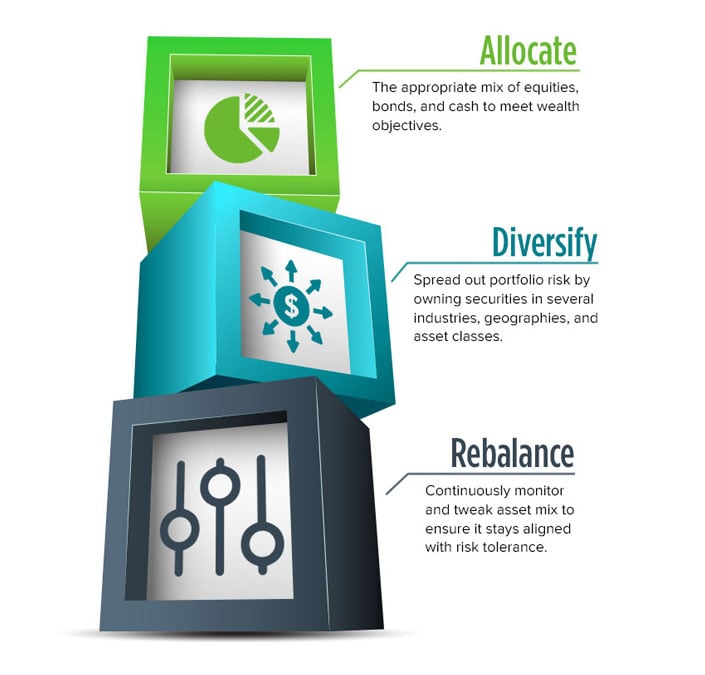Overwhelmed with managing your investment portfolio? Confused about where to pull income from in retirement? Unsure what to do with your 401(k) after switching jobs? Concerned about how to grow your wealth?
These are some of our clients' questions when they approach us for investment portfolio management. Because many individuals want to grow their assets but are unsure of how or where to start.
Each person's financial position and goals differ. You may want to retire at age 55, but your sister may have young children and need to save for college. Even if you know where you are—and where you'd like to be with respect to your money—getting from point A to point B can be daunting. An investment manager can help.
Investment portfolio management goals and objectives are unique to you
The objectives of portfolio management center around your wealth goals, including your unique financial milestones. These are influenced by a discrete time horizon and attitude about risk—both tolerance and capacity.
Risk tolerance refers to how much potential downside you can stomach before constant worry keeps you up at night. On the other hand, risk capacity refers to your ability to afford potential losses. It’s important to consider both. If the risk of loss causes constant anxiety, then the risk level is above your tolerance. Likewise, if a significant market downturn could result in a devastating loss that you cannot afford, the risk level is above your capacity. The goal is to strike a balance between being too conservative and positioning for growth.
Investment management gives you potential performance and peace of mind
While your portfolio should reflect your attitudes and objectives, it has one ultimate goal: Giving you peace of mind while knowing that your money is hard at work. We believe that this is accomplished in a three-step process.

- Asset allocation. Your goals inform your optimal investment portfolio allocation—the appropriate mix of equities, bonds, and cash. Whether your investment objective is growth, income, or preservation of capital, asset allocation combines strategies to achieve those results. For example, you may seek monthly income while looking to grow your principal. In this case, you might see a portfolio constructed of dividend-paying stocks and investment-grade bonds. The mix might be 70% stocks and 30% bonds or other ratios depending on your age and risk tolerance. With investment portfolio management, as time passes and your goals change, the composition of your portfolio will be adjusted to reflect your new circumstances.
- Diversification. One of the best ways to mitigate risk is to spread it out. The more individual stocks you own, the less likely poor performance among two or three companies will drag down your overall investment returns. Diversification also involves investing in unrelated asset classes. If U.S. stocks are having a rough quarter, the same might not hold true with international stocks. Tangentially related to asset class diversification broadens the scope of strategies employed within your portfolio. For example, some exposure to “alternative” strategies (such as hedge equity or “long-short” strategies) and private fund investments (e.g., private equity, venture capital) may round out your portfolio if you have the appropriate level of assets and financial sophistication. These concepts may help control a portfolio's volatility—its drastic up-and-down swings.
- Rebalancing. This is an essential part of portfolio management. The mix of assets is continuously monitored and tweaked to ensure that it stays aligned with risk tolerance and financial goals. To illustrate, let's assume you chose to have 30% of your money in growth stocks. A robust economy moved the value of those stocks to 40% of the overall portfolio. An investment manager would rebalance the portfolio, so the percentage of growth stocks falls back to 30%.
Alleviating stress with portfolio management services
Many individuals manage their own portfolios. But even if you’ve been successful in the past, as circumstances complicate or retirement looms, you might want to enlist the help of a professional Wealth Advisor and money manager to help strategize and aim to achieve your wealth plan. That way, you could kick back and leave the money management to a skilled team of investment professionals.

Like what you're reading?
Join the thousands of readers getting stories like this delivered straight to their inbox every Thursday — for free. Give it a spin, enter your email to sign up.
Related Articles

Everyone Needs an Estate Plan, Whether You Have $1K or $1B
There is a common misperception that estate planning is only important for very wealthy people, or...

Do Your Heirs Want an Inheritance?
Depending on how your loved ones look at it, an inheritance may be a financial blessing or a...

Which Trumps: Your Will or Beneficiary Designation?
You have worked hard for your wealth. The last thing you want is for it to go to the wrong...
